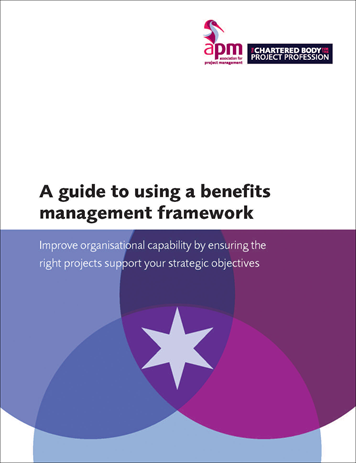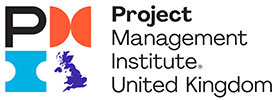Webinar Description
Every programme and portfolio now uses benefits management processes to demonstrate return on investment. However, benefits management isn’t applied consistently to all projects and programmes at all phase-gates, which means that decisions on what to increase/ decrease/ start/ stop are made without being able to make proper comparisons.
A benefits management framework delivers two things: 1) consistency, allowing better decisions and delivering more success, and 2) application of benefits management throughout the life cycle, from problem definition through to lessons learnt.
This webinar supports the APM publication “A guide to using a benefits management framework” and takes participants through the implementation process, from developing and refining the benefits management methodologies you will use, through which programmes to migrate when, to structuring portfolios, tranches and stage gates and taking action on deviation from plan.
Video Link to Webinar Recording
About Hugo Minney

Hugo has worked in project management in many different settings but has probably never once had the job title of ‘Project Manager.’
From ‘Account Manager’ (developing the specification and organising delivery and implementation), through ‘Workforce Designer’ (creating new ways to overcome constraints), ‘Benefits Manager’ (coaching stakeholders what they can expect and what they have to do to get it), to a recent role as ‘Chief Executive’ (responsible for making it happen), Hugo has worked across industries in Commerce, in Charity and NHS.
Through all of this, Hugo has maintained a focus on value - the value that the user and the customer get, and why they would want to get (or buy) more.
Hugo is a Chartered Project Professional and the Chair of the Benefits and Value Specific Interest Group (SIG), as well as on the committees of Enabling Change SIG and North East Branch. He’s a committee member of BSI (British Standards Institute) as subject matter expert for a forthcoming benefits management standard.
Webinar Presentation Slides
Q&A
Q1. How do we adequately persuade from a programme level, that those at a portfolio level, they should be measuring value (benefits) at a portfolio level?
A1. Thanks for the question, this is a common problem. The issues are (in my experience: I'd be interested if you have different experiences):
1) if benefits management is different on different programmes, it's difficult to compare one programme with another at portfolio level so they just end up with hundreds of dissimilar benefits; and
2) if benefits are measured in different ways using different units, then they can't be combined in ways that make sense at portfolio level so we're back to the problem highlighted in (1).
The answer, of course, is to use a framework. Benefits management is great for aligning the programme stakeholders around the objectives, motivating the project team and those who receive the capability/have the change done to them, so benefits management both motivates and ensures return on investment (in whatever form the investment is made - money, time, reputation, focus etc).
However, a framework allows cross-organisation understanding, the progressive realisation of objectives, and for decisions to be made about the allocation of scarce resources (money, specialist skills, etc etc) because programmes can be compared and their likely return contrasted. This is particularly important on a dynamic basis.
So the next issue is how to "retro-fit" benefits management to existing programmes, and the guide book specifically looks at retro-fitting to programmes in flight (making better decisions from this point on), almost closing (learning lessons) as well as just started and still going through the business case, and the best point, whilst the problem or opportunity is still being defined.
A key aim is to identify a small number of "common currencies" (see another answer A5) which would allow all benefits (for a programme, a portfolio, or across a number of portfolios) reported in a specific currency to be added together which means they can be reported on a higher dashboard.
Portfolios are supposed to give a helicopter view - if you still have to look at all the detail and can't combine and summarise, then you haven't got the helicopter view. Portfolios are supposed to make strategic decisions - and it's difficult to be strategic when you are up to your knees in detail. But the summary has to be based on evidence, facts and detail.
Q2. Hugo, in your experience, do you find that take up of value management is higher and more likely in public services, as opposed to private business?
A2. Personally I'd say that the private sector is more concerned with value management than the public sector, ensuring return on investment (where the investment may be money, time, focus, reputation and the return may be profit, increased share price, increased intellectual property, reputation (with corresponding impacts on recruitment / retention / sales).
The public sector is more likely to focus on specification and what can be controlled - the project approach. Government is trying to mandate benefits management, but in some cases does it very badly, and in others meets huge resistance (project managers are control freaks - it's in the genes. But benefits are delivered outside of the control of the PM.
Q3. I just voted (in the survey within the slide deck) that I occasionally see fully costed cases, but it's more likely to be very ad hoc. How do we get the business to change from this, to portfolio engagement?
A3. See the question on lifting from programme to portfolio level (Q1/A1). Once the portfolio is able to take a view across more than one programme, they are going to start highlighting the programmes that don't report properly. The next stage is to bring in strict phase gates/stage gates, but you need the whole board to enforce it and refuse to allow their pet projects to bypass the phase gates. When the phase gates won't let anything past without proper benefits management then you will have proper benefits management across your organisation.
But that depends on having a framework - you can have any benefit you want but its stakeholder needs to be clearly identified, the common currency that it's reported in needs to e on one of your executive/ portfolio/ etc. hierarchical level dashboard, and if these are fulfilled then it can be used for decision-making especially to compare one investment with another.
Those who aren't confident that their programme is any good will resist verifiable comparisons, and you will need to find diplomatic ways to ‘out’ them.
Q4. We’re managing benefits using APM standard across a portfolio. I’ve been looking at Management of Value (MoV). What do you think about bringing in MoV?
A4. I'm a standards person. I use existing standards right up to the point that they don't work, and even then I would seek to retain most of the standard approach and only modify the bit that needs improvement. I'll go further - novel approaches haven't been tested in the heat of engagement and you will probably come a cropper if you rely on them.
So MoV, which has been tested in the white heat of delivery, is a very good way to approach it. Obviously there are other tried-and-tested approaches, and they work too. Which is better? The one which helps with communication in your situation and circumstance (often the one most compatible with your project/ programme/ portfolio management approach). A few years ago, Benefits Management SIG ran an "advanced benefits mapping" workshop in London, where we compared at least 4 different methods of benefits mapping. They all work, some are better in specific circumstances, but they all work!
Q5. Common currencies were mentioned for measures, outside £/ $ what might these be for the purposes of comparability?
A5. As I mentioned during the call, I'm currently working at Sellafield Ltd. The organisation's summary objectives are:
- reducing risk and hazard,
- improving the green environment,
- improving the local economy, and
- best return on taxpayers' money.
A first pass on common currencies would be: a measure (or perhaps 2 or 3 measures if one won't work) for risk and hazard, a measure on improved environment, and £ (the local economy can be measured in £, just as return on taxpayers’ money can be measured in £). I'd add to this: years of earlier delivery (measured in time), and probably saleable skills although this could be translated into £ as well.
In a different context, e.g. military and defense, you'd be looking for some way to measure deterrent and reduced risk (although these may overlap with SL's reducing risk and hazard), and in higher education you might use contributions to the university ranking (because you know how published research and citations contribute towards these, and you know what impact it has on recruitment and income).
In a health and care environment, a great many things can be reported in £ (reduced future costs of care due to prevention; economic productivity due to health and mobility) but quality of life may be expressed in QALY (Quality Adjusted Life Years), and intellectual property could also be one of the common currencies used for reporting particular types of benefit.
Ideally you'd want 2 or 3, no more than 9 (3 * 3 dashboards in a square) common currencies which all benefits would use, but as Einstein is supposed to have said, make it as simple as you can without making it too simple.
Q6. How far do you go to identify and measure benefits for a project or programme, at what point does it become an unsustainable overhead?
A6. Case by case basis. As I emphasised in the webinar, everything can be measured (one of my contributions to the Global Value Exchange GVE is a ‘£’ figure for the amount parents love their children) but that doesn't mean that you should measure everything. If what you are trying to measure is very difficult to measure, but the project or programme is a huge investment, then it may still be worth going through the investment of finding a way to measure it.
In the course of searching, you may find it wasn't as difficult as you thought. For example, I ask front-line staff what they think is important to know. They take pride in entering the information accurately because they want to see the results. Because they are motivated, it costs almost nothing to measure. And the clarity drives good behaviours, including better service delivery (BAU), small continuous improvements instead of occasional big disruption, and motivation.
Q7. Where would you put NPV in the mix - my experience is of economic value being a key metric for decision making and looking at sources of value
A7. I'm sorry if I was a little dismissive during the webinar. Most people use 3.5% as the adjustment for NPV, which means it only starts to become noticeable over significant time periods (by which I mean, the uncertainty for most costs, let alone benefits, could be a factor of 2 so NPV would have to be more than 50% before it's important which means time periods of around 13 years or more).
Having said that, it's so straightforward to calculate that you could just do NPV all the time. I note that Treasury Green Book 2018 has changed all references to NPV into references to NPSV - Net Present Social Value, although the calculation and factor remains the same.
If it were me, I'd use NPV or NPSV all the time without thinking about it. Another of my contributions to the Global Value Exchange is a calculator for inflation, which allows you to specify a particular aspect of society (for example, inflation in technology has gone the opposite way to inflation on houses, which are extremes compared to Consumer Price Index).
Q8. How should assurance of a project look at benefit management - would it be appropriate to include it as part of looking at the arrangement for the project solution.
A8. Benefits management needs assurance at least as much as any other part of project (PPP) management. I don't shout about it because there used to be a tendency for each specialist area of project management to claim they encompass every other area, whereas i take the view that there are only 168 hours in a week, and therefore I'm going to stick to my knitting and call in experts for their parts.
But this is another way that a framework adds a whole extra dimension (taking benefits management in 2 dimensions up to a framework in 3 dimensions) and allows the organisation to prioritise.
Benefits management allows stop/go/decrease/increase decisions. The framework allows you to make these decisions in the context of allocating limited resources. And in order to make decisions, you need to be able to compare like with like, which means assurance that when someone says "this is measured in hours and reported in £, that is measured in jobs created and reported in £" the conversion to common currency is true, and the comparisons are valid.
Further Reading
A guide to using a benefits management framework
"Very few people have experience of creating benefits management frameworks at an organisational level from scratch. This guide is written by people who do..."
Dr Hugo Minney and Sarah Parris, with the APM Benefits and Value SIG, explain the process of creating and embedding a benefits framework in an organisation. In doing so they show how a framework will standardise how benefits are managed across projects, programmes and portfolios, and how you can align project benefits to strategic objectives and KPIs. They also provide valuable insights, including the best tools, templates and techniques, the likely challenges and obstacles to success and examples of frameworks that work.
"The guide develops an understanding of the need for benefits realisation, offering a framework for addressing contextual factors and developing the capability to realise benefits."
Click here to purchase your copy of the guide

